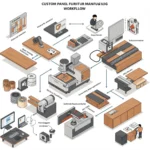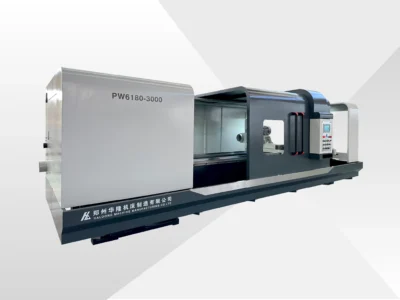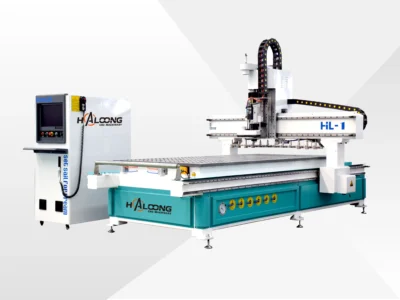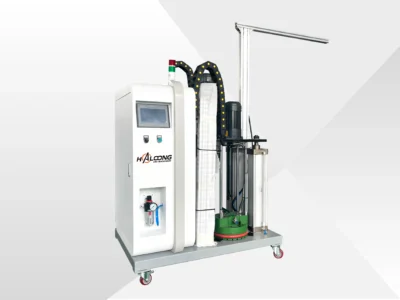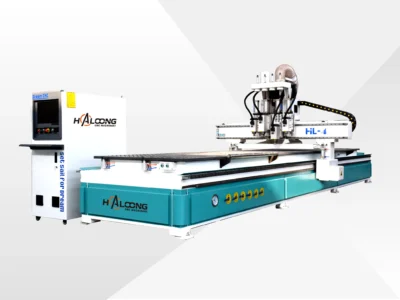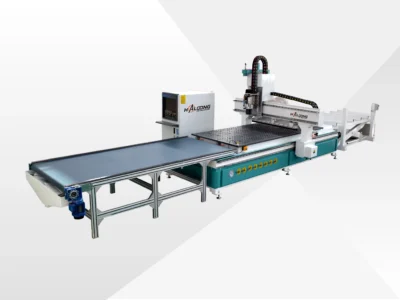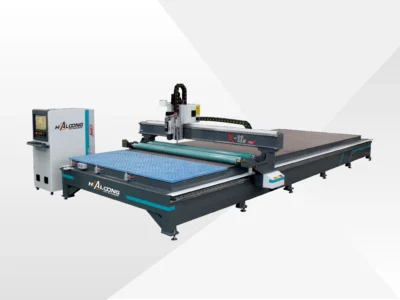
Multi-Head vs. Linear ATC CNC: Choosing the Right CNC Router for Your Custom Furniture Business
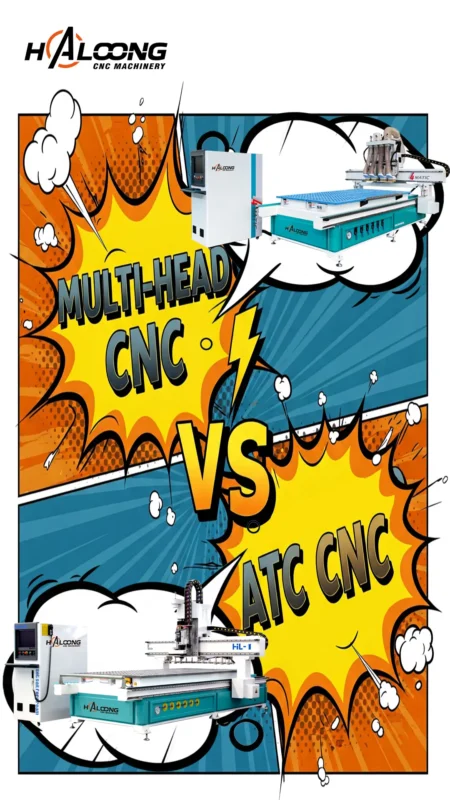
Introduction
Many first-time buyers in the custom furniture or cabinet making industry face a challenging decision: Should you invest in a Multi-head CNC Router or a Linear ATC (Automatic Tool Changer) Machining Center? Understanding the core differences in performance, cost, and application is crucial for making the right choice for your business. This comparison will guide you through the key factors to consider.
1. Key Configuration Differences and Tool Changing Methods
While the overall footprint and main structure of these machines might appear similar at first glance, the critical distinction lies in the spindle configuration and tool changing mechanism.
- Multi-head CNC Router: This machine typically features multiple (often four) independent spindles. Each spindle can have a respectable power rating (e.g., up to 7.5 kW). Tool selection happens rapidly by activating the specific spindle holding the required tool. This allows for near-instantaneous “tool changes” between the pre-loaded tools.
- Linear ATC Machining Center: This configuration uses a single, often more powerful spindle (e.g., up to 9 kW) capable of higher rotational speeds (e.g., up to 24,000 RPM). Both power and speed generally surpass those of individual spindles on a multi-head machine. Tool changes occur when the spindle automatically travels to a linear tool magazine (rack), deposits the current tool holder, and picks up the next required tool holder.
2. Cost Considerations: Initial Investment, Operation, and Long-Term Ownership
- Purchase Price: Generally, the initial investment for a Linear ATC machine is higher than for a comparable Multi-head machine.
- Operating Costs: Day-to-day operating costs (power consumption, basic consumables) don’t usually differ significantly. However, equipping a Linear ATC’s tool magazine might require a larger initial investment in a diverse range of tool holders and cutters compared to the typically fixed tooling on a multi-head machine focused on specific tasks.
- After-Sales Costs & Downtime: This is where long-term costs can diverge significantly.
- Spindle Replacement: Repairing or replacing the single, high-performance spindle on a Linear ATC machine typically costs 2-3 times more than replacing one of the simpler spindles on a Multi-head machine.
- Production Continuity: A critical factor is downtime. If one spindle fails on a Multi-head machine, production can often continue using the remaining spindles, minimizing disruption. However, if the single spindle on a Linear ATC machine breaks down, the entire machine is out of commission until the repair is completed. This can severely impact production schedules, especially if it’s the primary nesting CNC in the workshop.
3. Processing Speed Comparison (Cabinet Production Test)
Efficiency is paramount. We conducted a direct comparison using nesting software to generate toolpaths for a standard wardrobe cabinet panel from a single sheet. The same program, material, and cutting parameters were used on both machine types. The process included drilling fastener holes, insert holes, dowel holes, grooving for back panels, and perimeter cutting.
Results:
- Multi-head CNC Router: Completed the sheet in 3 minutes and 56 seconds.
- Linear ATC Machining Center : Completed the same sheet in 4 minutes and 39 seconds.
Analysis:
For standard cabinet processing involving frequent changes between drilling, grooving, and cutting tools, the Multi-head machine demonstrates a distinct speed advantage. Its rapid spindle switching eliminates the time the ATC spindle spends traveling to and from the tool magazine. Across multiple tests with varied panel layouts, the Multi-head machine consistently finished approximately 1 minute faster per sheet.
Productivity Impact:
Processing 60 sheets per day, the Multi-head machine could save roughly one hour of production time compared to the Linear ATC. In a standard 8-hour workday, this translates to potentially processing around 10 additional sheets, significantly boosting output.
4. Summary: Key Strengths
- Multi-head CNC Router (e.g., HALOONG ROUTER MASTER 4-Matic):
- Optimized for Speed: Specifically developed for high-efficiency cabinet production.
- Rapid Tool Switching: Ideal for processes requiring frequent use of a limited set of tools (various drills, groover, cutter).
- Reduced Downtime Risk: Failure of one spindle doesn’t halt production entirely.
- Linear ATC Machining Center (e.g., HALOONG ROUTER MASTER 12-Li):
- Versatility: Larger tool magazine capacity allows for a wide variety of tools (e.g., cutters for invisible connectors like Lamello, diverse drill bits, specialty cutters, profile/molding tools) to be ready simultaneously.
- Flexibility: Better suited for mixed production (cabinets and complex carving), intricate work, or jobs requiring many different tool profiles.
- Higher Power/Speed Spindle: Offers potential for faster cutting speeds in certain materials or single-tool operations, and handles demanding tasks well.
5. Direct Purchase Recommendations
Let’s get straight to the point:
Choose the Multi-head CNC Router if:
- Your primary business is high-volume cabinet production.
- You produce both cabinets and carved elements, but cabinet volume is significantly higher, and speed for cabinets is the priority.
Choose the Linear ATC Machining Center if:
- Your primary focus is complex carving, engraving, or multi-tool processes.
- You produce both cabinets and carved elements, but carving/complex work volume is higher or requires greater tooling flexibility.
- You need to efficiently produce cabinets using invisible hardware systems (e.g., Lamello, OVVO, U-shaped connectors) or other specialized joinery requiring dedicated tools readily available in the magazine.
- Future business plans involve diversifying into more complex or varied types of production that benefit from high tool capacity.
- Resale value is a major consideration (Linear ATC machines often hold their value better).
For Workshops with High Budgets and Diverse Needs: If budget allows and production demands are varied, having both types of machines can offer the ultimate flexibility, allowing you to assign jobs to the most suitable machine.
Final Note
Choosing the right CNC machine is a significant investment. We hope this comparison clarifies the key differences between Multi-head and Linear ATC routers for custom home furnishing applications.
Do you have questions about aspects not covered here, or need help evaluating your specific production requirements?
- Leave a comment below to join the discussion!
- Contact our expert team today for a personalized consultation.
- Request a quote for the HALOONG CNC ROUTER model that best fits your needs.
Related Products
HALOONG CNC Cylindrical Shaft Polishing Machine
Dual Station Table Linear ATC CNC Wood Router: Automatic Tool Changer Wood CNC for Furniture Making
Why the HALOONG 12-Tool ATC CNC Wood Router Stands Out
The HALOONG 12-Tool ATC CNC Wood Router is a high-performance wood CNC machine built for exceptional efficiency and flexibility. Its automatic tool changer (ATC) switches between 12 tools in under 5 seconds, drastically reducing downtime and boosting output. Whether you’re cutting MDF, carving solid wood, or crafting intricate designs, this CNC wood router handles it all with ease. For even greater productivity, consider our optional dual-table configuration, which allows for near-continuous operation and significantly increases throughput for demanding production schedules.
Key Features of This CNC Wood Router
Here’s what makes this wood CNC a must-have:
Ultra-Fast Tool Switching
- 12-tool linear magazine: Holds a variety of tools, ready for instant use.
- Tool changes in under 5 seconds: The gantry-integrated design cuts travel time, keeping your production moving.
Versatile Material Processing
- Works with MDF, solid wood, OSB, PVC, acrylic, aluminum, and composite panels.
- Supports standard furniture joints (e.g., dowels and cams) and modern invisible connectors (e.g., Lamello, Peanut, Lockdowel).
- Perfect for cabinets, wardrobes, doors, and artistic carvings.
Customizable Worktable Options
- Options like 4'x8' (1220x2440 mm), 4'x9' (1220x2800 mm), or custom sizes available for single-table models.
- Maximize your output with our optional dual-table configuration, allowing for continuous loading and unloading on separate work zones.
- Upgraded vacuum table locks materials securely for flawless results on both single and dual-table setups.
Effortless Operation
- User-friendly controls with a clear display, network, and USB connectivity.
- Simplified design means even beginners can master it quickly. The dual-table operation is also intuitively managed through the advanced control system.
Built to Last with Precision
- Heavy-duty steel frame and high-precision gearbox for durability.
- Servo-driven system ensures smooth, accurate cuts every time. The robust construction ensures stability even during continuous operation on the dual-table model.
Cleaner, Safer Workspace
- Integrated dust collection and air-blow system keeps debris in check.
- Ideal for continuous, high-output runs without mess, making it perfect for the increased production demands of the dual-table system.
Top-Notch Support
- Free technical support, lifetime service, and remote assistance included.
PUR Glue Machine Kit For Edge Bander
Four-Spindle Dual-Station CNC Wood Router for Panel Furniture Manufactured
Maximize your panel furniture manufacturing throughput with the HALOONG Four-Spindle Dual-Station CNC Router. Expanding on the reliability of our single-station four-spindle CNC wood cutting machines, this dual-station system provides a substantial increase in production efficiency. It's designed for continuous operation, minimizing downtime and maximizing output through its smart workflow.
The clever dual-station workbench facilitates seamless alternating work cycles. While one station is engaged in machining, the operator can efficiently prepare the next batch of materials on the adjacent station. Upon completion of the first cycle, the machine instantly transitions to the pre-loaded second station. This continuous processing approach ensures no wasted time, making it a key asset for high-volume furniture production.


